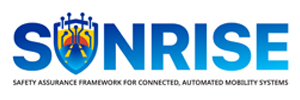Developing and providing a harmonized
and scalable CCAM Safety Assurance Framework
About us
SUNRISE (Safety assUraNce fRamework for connected, automated mobIlity SystEms) will develop and demonstrate a commonly accepted, extensible Safety Assurance Framework for the test and safety validation of a varied scope of CCAM systems. This will be achieved by:
- Bringing the needs of heterogeneous CCAM use cases
- Defining a scenario-based database framework that will broaden the HEADSTART methodology
- Holistically addressing the CCAM test scenario generation;
- preparing the required tools for comprehensive testing (virtual and physical), taking into account robustness, scalability, interoperability, quality and standardization;
- integrating functional safety and cybersecurity
- involving the use cases from the initial stages, acting as a guiding principle within the project.
The project will define, implement and demonstrate the building blocks of this Safety Assurance Framework: harmonized and scalable safety assessment methodologies, procedures and metrics tailored for use cases, a federated European Scenario Database framework and its necessary data interfaces, a commonly agreed simulation framework including tools and interfaces. SUNRISE will work closely with CCAM stakeholders as policy makers, regulators, consumer testing, user associations and all relevant stakeholders.
Objectives
Overcoming the challenges CCAM technologies and systems face in terms of safety assurance for their broad adoption
Allowing large-scale deployment of CCAM
Proving that CCAM is safe and reliable in every possible driving scenario
Activities
Shaping harmonized and scalable safety assessment methodologies and certifications
Creating a federated European Scenario Database framework and a commonly agreed
Engaging with stakeholders worldwide
Use cases:
Urban AD validation (ODD: intersections)
Traffic Jam AD validation (ODD: highway)
Highway AD validation (ODD: highway)
Freight vehicle automated parking validation (ODD: logistic terminal, connectivity, light rain or attack injection)

Frequently Asked Questions (FAQ)
with Stefan de Vries, SUNRISE Project Coordinator
In the context of CCAM, what is Safety from the perspective of SUNRISE?
From the perspective of the SUNRISE project, safety is about ensuring that automated vehicles can operate in our everyday traffic without causing harm to people or property. SUNRISE views safety as the absence of unreasonable risk when automated vehicles drive on public roads. This means making sure these vehicles can handle all the situations they might encounter — from everyday driving to unexpected events — without causing accidents.
How does SUNRISE address the perception gap between technological safety advancements and public trust?
Based on collaborations with other EU-funded projects like SINFONICA and OptiPEx, SUNRISE understands that CCAM systems are generally trusted to be safe by the general public. However, SUNRISE acknowledges the possible risk of a gap between technological safety advancements and public trust in CCAM systems. SUNRISE recognizes that managing expectations and building trust through transparent communication are key to addressing the gap between technical safety advancements and public acceptance of CCAM technologies.
Do you foresee risks associated with the intersection of safety and technologies, and how could these be managed?
As mentioned in the previous answer, SUNRISE recognises that managing expectations and building trust through transparent communication, are key to addressing the possible gap between technical safety advancements and public acceptance of CCAM technologies. Based on collaborations with other EU-funded projects like SINFONICA and OptiPEx, here’s how SUNRISE thinks that can be realised:
- By transparency on safety procedures and protocols, which is emphasized as critical for gaining trust
- By informing the wider public about CCAM system safety through established mobility-related groups
- By increasing the focus on inclusivity and highlighting general benefits of CCAM
- By increase the focus of future remphasisedesearch on mobility underserved/poor groups in CCAM safety assurance
- By utilising popular tech platforms such as LinkedIn and YouTube for outreach.
